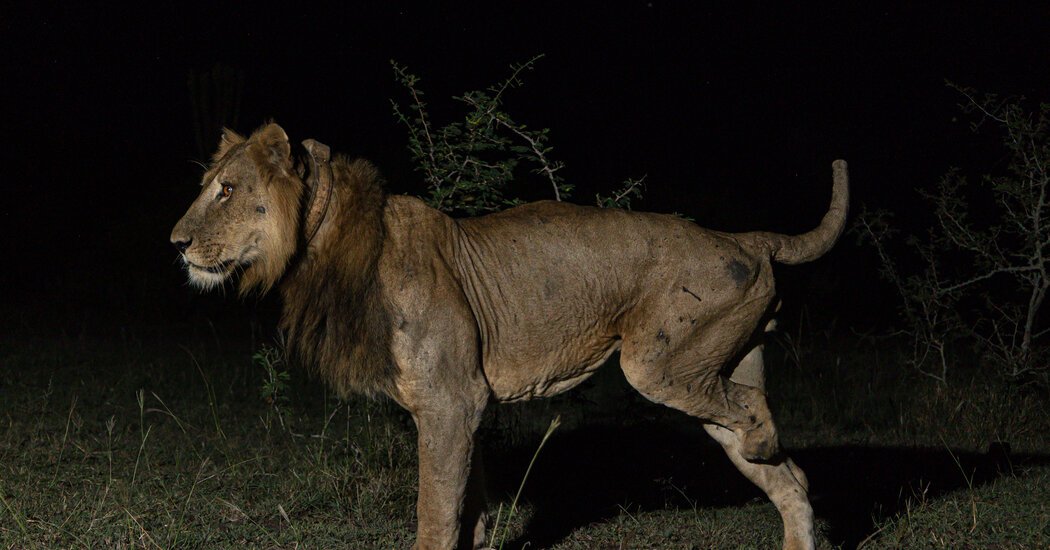On a dark night in February, two male lions stood in the shallows of the Kazinga Channel in Queen Elizabeth National Park, in Uganda, and looked across the water. Nearly a mile away was the shore on the other side. Hippos and 16-foot crocodiles inhabit the channel, which can be 20-feet deep in places.
Barely 12 hours earlier, the two males had lost a battle for territory and were lucky to still be alive. Remaining on this side of the channel was dangerous, and they could probably hear the roars of female lions in the distance.
As with many cat species, lions don’t like to swim. And one of the lions, known as Jacob by researchers, has only three legs. He lost a limb in a poacher’s trap in 2020. But neither Jacob nor his brother, Tibu, were deterred. The two big cats set out for what the researchers call the longest-recorded swim ever taken by lions. The scientists describe their findings in a paper that has been accepted for publication in the journal Ecology and Evolution.
The lions struggled on their first three tries to cross. During the second attempt, the drone that was tracking them picked up a large thermal signature that may have been a crocodile or a hippo in pursuit; the two male lions split into a Y formation before hurrying back to shore.

Less than an hour after their first attempt, the two set out again for a third time. The path seemed clear and they kept going until they crossed the channel.
“It was pretty dramatic,” said Alexander Braczkowski, a conservation biologist working with Griffith University in Australia and Northern Arizona University who has been studying the lions since 2017. “It looks like two tiny little heat signatures crossing an ocean.”
The Kazinga Channel cuts the national park in two. Dr. Braczkowski and his team had seen Jacob and his brother on the other side of the channel three times, and had assumed that the lions had swum between the two shores. But they had lacked recorded proof of the lions swimming all the way across.
Lions have been observed swimming in Okavango Delta in Botswana, but rarely farther than 150 feet. In 2012, a lion swam around 330 feet across the Zambezi River, from Zimbabwe to Zambia. In November 2023, a young male lion swam across the Rufiji River in southern Tanzania, crossing as much as 985 feet of water. Anecdotal evidence suggests that lions have swum between the shore of Lake Kariba (also on the border between Zambia and Zimbabwe) and one of the lake’s islands, a distance of 0.6 miles, although this has never been confirmed on video.
Other big cats are more at home in water. Jaguars are known to hunt caimans in rivers in Brazil. A 2022 study reported a swim of nearly three-quarters of a mile by a mountain lion in the Puget Sound off the coast of Washington State. In the same year, a male tiger swam a similar distance across the Brahmaputra River in northern India.
But Dr. Brackowski estimated that the two lions in Uganda swam nearly a full mile across the Kazinga Channel.
Why would lions make such a dangerous crossing?
“Sex,” said Craig Packer, who ran the Serengeti Lion Project for 35 years and wasn’t involved in the study. “If there’s nobody to mate with, what are you doing? You’re a male lion. You don’t have a very long life span, so you have to get on with it, especially if you’re wounded.”
Local conditions also played a part. According to Dr. Braczkowski, the park’s lion population has fallen to around 40 today from 71 lions in 2018, with at least 17 lions, mostly females, poisoned by nearby residents aiming to protect their livestock. Males outnumber females two to one.
“These males and these swimming events are a symptom of this problem,” Dr. Braczkowski said. “The males are not finding females in the area where they had tenure. The only females they can get to may be across the channel.”
In such circumstances, Dr. Packer said, lions may decide to take their chances elsewhere.
“If they can tell that there are females over there and no males, it would be, ‘Sign me up! Sign me up!’” he said.










